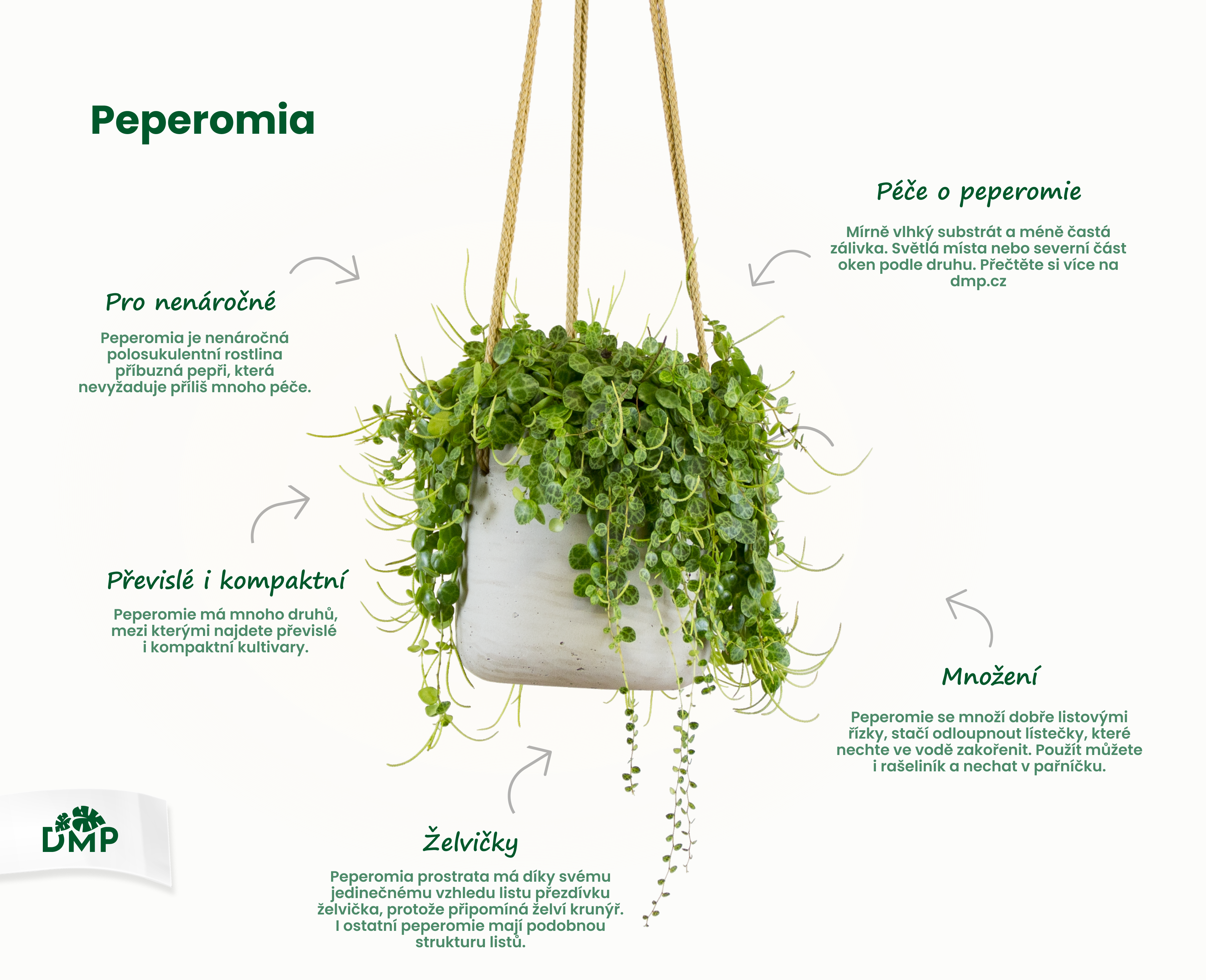Peperomia, or peppermint, is easy to care for

This is a very popular houseplant. Due to its diversity, we can choose from many shapes and thus complement the interior perfectly. It will be a welcome gift as it should not be missing in any flower lover's collection.
We can also use its ability to filter formaldehyde from the premises. This will come in handy if we bought chipboard furniture at home. Because the plant is not poisonous , we can place it with a clear conscience in children's rooms or in apartments with pets.
Which kind to choose?
Peperomia has hundreds of species, originating from Central and South America. It is also found in Africa and South Asia. It is a plant from the Pepper family, i.e. related to the well-known pepper. For many years it was called Peperomia sandersii. Most of their species that we can grow have a specific and distinct leaf pattern.
For a hanging plant we can choose, for example, Peperomia Tetraphylla Hope or the even more popular Peperomia Prostrata , which resemble small turtle shells, which is why they are also called 'turtles' . If we are looking for a compact solitaire, Peperomia Caperata Lilian will be suitable .
They are small plants that rarely exceed a height of 20-30 cm. Even so, it cannot be underestimated, because its stems grow very quickly, up to 10 cm per year.
This beautiful roommate also has its own flowers. He gives us it most often in the summer months. These are characterized by a white color and usually contrast with the shape and color of the leaves.

Photo: Peperomia Raindrop
How to take care of them?
To maintain a compact shape, the plant must be divided into at least 2 pieces. With the proper care that peperomia requires, its shape remains intact. However, if we want more offshoots from one plant, we divide it into up to 4 pieces. We will plant them in individual flower pots. However, until the plants are properly established, the plant must be kept in a higher humidity. We will ensure this using a regular sprayer or air humidifiers.
An interesting fact is that plants with stiff leaves can live happily even in dry, heated rooms. Conversely, Peppers with soft leaves already need higher air humidity. It should be remembered that we do not place the plant on the south side or for heating. She does not like dry air and drafts. On the contrary, we will make it the happiest if we place it, for example, in the kitchen or near it.
Light conditions.
These plants do not need much light. If we place them in direct light or sun, its leaves could begin to wilt and fall off. For this reason, it is also necessary to protect them from high temperatures. At temperatures above 24 °C, she will no longer be completely satisfied. On the contrary, if you reduce watering, it will be happy even in colder rooms. For this reason, we can buy it without any worries even in the winter months.
Topping and environment.
Peppermint loves moisture and heat. However, this does not mean that we will overwater them. It is necessary to adhere to a moderate irrigation and always pour it ideally into a sub-dish.
If a large amount of water were to get on the leaves or in their folds, the plant could begin to rot. In the winter months, we leave it without watering for 2 to 3 weeks without problems. It can therefore be suitable for those who sometimes forget to water the flowers, as well as for those who often travel for a long time. We never leave it standing in water. Every dry or rotting leaf or stem needs to be carefully removed to keep the plant happy. They will appreciate standing non-calcareous water, which we can even water the plant with. They will appreciate it if we place it in small glasses or window showcases.

Photo: Peperomia reproduces well from leaf cuttings. Just leave the broken leaves in water and in a few weeks they will grow roots and new twigs will start to pop up.
Fertilization and propagation.
Just like peperomia, it doesn't need a lot of watering, it doesn't need a lot of fertilization. During the summer months, we add half the recommended amount of fertilizer to the watering. Fertilize every 2 to 3 weeks during the growing season. With regard to dosage, we prefer liquid fertilizers. ( Forestina universal fertilizer (dmp.cz) .
To propagate this plant, we take the top ends of the plant, which we stick into smaller pots. We then cover them with a microtene bag or food foil. We can support their successful propagation by placing them in a small greenhouse or propagator.
If we accidentally tear off a ticket during manipulation, it is not a disaster. We will use it for another multiplication option. We put the leaf itself in a cup or glass with water. In about 2 weeks we can observe the first roots of Peperomia. Such observation of growth will be appreciated by us and the children.
Problems and pests.
What problems can they have? If we notice a fading of the leaves on the plant, it means that it is placed in a very bright place. So just move it to a shadier place.
If, on the other hand, the leaves start to fall, it is probably cold. We can try to put it in a warmer place and thus prevent further loss of tickets.
If the leaves and stems start to turn black, the plant is overwatered. Then a possible solution is to remove the plant from the wet bale and transfer it to a dry substrate. Regularly rotting leaves and stems must be carefully removed. In the end, we can always save the plant by propagating using top cuttings or by dividing it.
The largest number of pests have fallen on this plant. You can recognize them from the small webs on the leaves. We will help Peperomia from them with a suitable spray.

Author: Nikola Soudek
-
Posted in
Péče o pokojovky




